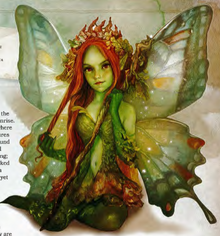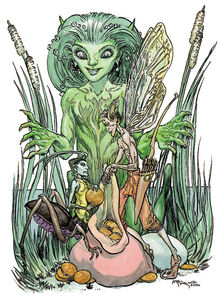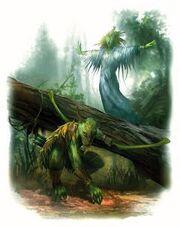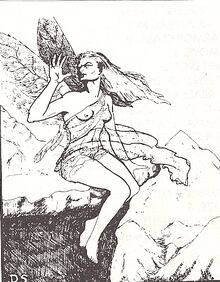
A pixie fairy from Dungeons & Dragons 5th edition.
A fairy (also fae, faerie, fay, fey, or fair folk) is a broad classification of supernatural being or spirit from the folklore of multiple European cultures (including Celtic, Slavic, German, English, and French folklore). They are magical creatures with a strong connection with nature or the wilderness, and may come from a sort of magic land or parallel dimension called Fairyland, Faerie, Arcadia, the Otherworld, or (in Dungeons & Dragons specifically) the Feywild.
Fairies take many forms and often have magical powers. In fairy tales, shapeshifting and transformation magic are common powers, as are flight and invisibility. Fairies are often fickle or trickster creatures, who might manipulate or play with humans for their own enjoyment.
Names and types of fairy[]

Examples of sprite fairies in Dungeons & Dragons. From left to right: a grig, a nixie, and a pixie.
Because fairy lore is a synthesis of many separate traditions, many different beings in folklore are now considered to be fairies or at least similar to them. The following are names given to fairy creatures in role-playing games:
- Atomie
- Boggan
- Boggart
- Boggle
- Bogie
- Brownie
- Clurichaun
- Ghillie dhu
- Grig
- Hag
- Leprechaun
- Nixie
- Pixie
- Pooka
- Redcap
- Sidhe
- Spriggan
- Sprite
- Sylph
Changelings are a type of fairy in folklore that has been exchanged for a human infant (or the human who has been raised by fairies in exchange), but the term sometimes applies in other contexts.
In role-playing games[]
Dungeons & Dragons[]

Killoren from Dungeons & Dragons
In Dungeons & Dragons, fey is a creature type that covers a wide range of creatures who originate from the Feywild (or Faerie or Arcadia, depending on the edition and campaign setting being used). Many traditional fairies are fey, as are satyrs and nymphs, rusalka, yuki-on-na and other creatures. Some original D&D creatures are also classed as fey, such as the blink dogs, faerie dragons, and killoren.
Fey are generally NPC creatures and monsters. However, some specific fey creatures are playable races in some editions of the game. In Dungeons & Dragons 4th edition, for example, hamadryads, pixies, and satyrs are playable races in the supplement Heroes of the Feywild; in 5th edition, centaurs and satyrs are fey playable races in the Mythic Odysseys of Theros setting sourcebook (although centaurs are not classified as fey in every D&D book).
White Wolf[]
In Changeling: The Dreaming, the player characters are half-human and half-fairies, cut off from their homeland of Arcadia and forced to balance the difference parts of themselves.
In Changeling: The Lost, the player characters are changelings, former humans who were kidnapped and transformed into fairy-like creatures in Faerie, now escaped back to the human world.
Connection with other beings[]

A sylph from Dungeons & Dragons
Many fantasy races that are now largely unconnected with fairies were inspired (wholly or partly) by fairy folklore, including banshees, elves, gnomes, goblins, hobgoblins, kobolds, and trolls.
Fairies are broadly similar in description and role to various other beings in other cultures, for example jinn and yōkai. They also have some overlap with beings like nymphs.
Fairies have been connected with elementals. For example, the alchemist Paracelsus described four elemental beings (salamanders, corresponding to fire; gnomes, corresponding to earth; undines, corresponding to water; and sylphs, corresponding to air), some of which have been associated with fairies either before or since Paracelsus' writings. Fairies have also been called spirits of the air.
Fairies have also been connected with angels and demons.
